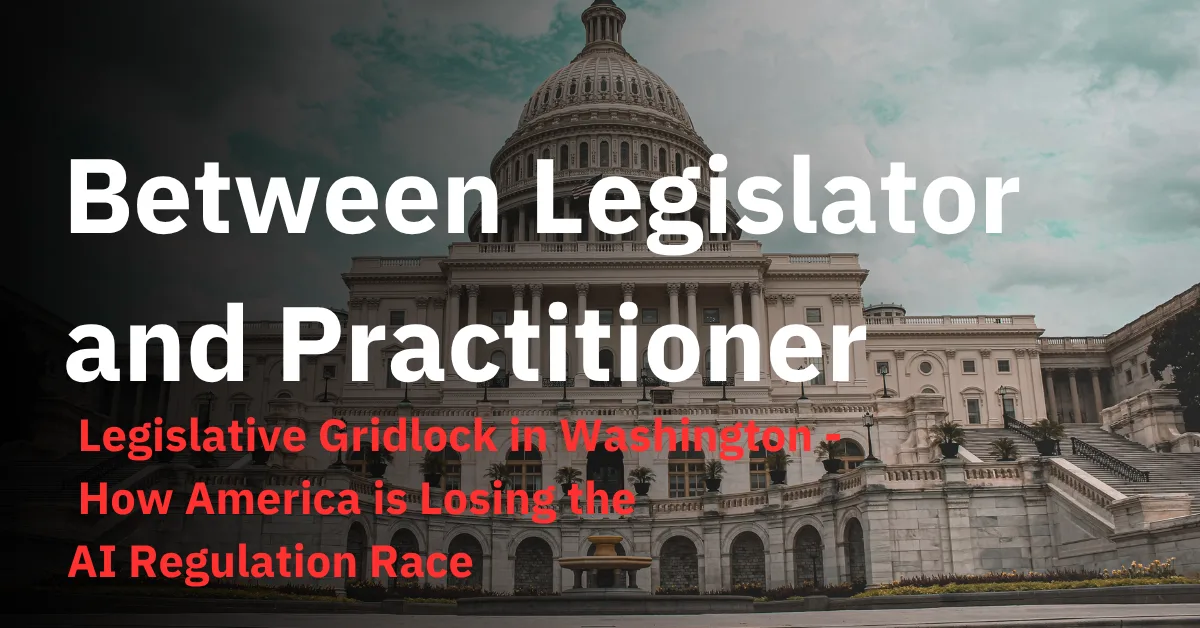Between Legislator and Practitioner: Legislative Gridlock in Washington – How America is Losing the AI Regulation Race
By Dr. Kholoud

Within the halls of the U.S. Congress, over a hundred draft laws to regulate artificial intelligence have been written, yet none have seen the light of day. While tech giants dominate the scene unchecked and nations race to control the future of this technology, the United States remains mired in the most complex regulatory crisis of the technological age. This is not merely a story of legislative delay, but rather a story of conflict between visions, ideologies, and interests that reflects one of America’s greatest paradoxes: how can the world’s greatest technological power fail to establish rules of the game for the revolution it is leading?
Within the current federal landscape, both the administration and Congress are attempting to address this dilemma through divergent approaches. On one hand, the administration issues executive directives like the “AI Bill of Rights,” but they remain ink on paper without binding force. On the other hand, members of Congress grapple between a desire to rein in tech giants and a fear of hindering American innovation. The result? Complete legislative paralysis and a dangerous regulatory vacuum that states are scrambling to fill with conflicting local laws, creating a complex mosaic of rules and regulations. The questions raised by this crisis transcend technical debate to become existential questions about the role of government and the limits of innovation: Can democracies keep pace with technological acceleration? Who will win the battle between Washington and Silicon Valley? And to what extent can we sacrifice protection at the altar of progress?
The legislative gridlock faced by the U.S. Congress stems from a genuine dilemma in crafting comprehensive AI legislation, where technical, political, and economic factors converge to form a barrier to any tangible progress. Technically, legislators struggle to establish fixed laws for technology evolving at a tremendous pace, where any proposed legislation becomes outdated before it’s even enacted. Politically, partisan division prevents consensus on a unified vision—Democrats push for strict regulation to protect consumers and workers, while Republicans prefer a liberal approach that encourages innovation and investment without constraints. Adding to these challenges are the intense pressures from tech lobbies seeking to maintain regulatory flexibility and operational freedom. The result is that over 100 bills remain stalled in congressional corridors, none able to overcome the political and technical obstacles, leading many observers to predict this gridlock will persist until at least 2026, while other countries accelerate to establish comprehensive regulatory frameworks that keep pace with the technological revolution.
In the absence of comprehensive legislation, the federal administration resorts to patchwork solutions to manage the regulatory crisis, most notably non-binding executive directives like the “AI Bill of Rights,” which focuses on data protection, privacy, preventing algorithmic discrimination, and ensuring transparency and accountability. However, these directives remain merely voluntary guidelines lacking binding force, limiting their real effectiveness in regulating the practices of tech companies. Concurrently, the federal government relies on a sectoral regulatory approach, where specialized agencies operate within their respective domains: the Federal Communications Commission regulates AI use in telecommunications, the Food and Drug Administration oversees medical applications of this technology, and the Department of Transportation sets standards for self-driving cars. This fragmented approach creates a heterogeneous regulatory system where standards and requirements differ from sector to sector, further complicating the regulatory environment and making compliance difficult for companies. This fragmented regulatory situation creates an environment of uncertainty with serious implications at various levels. Tech startups face immense compliance challenges, forcing them to navigate different systems in each state, raising legal and administrative costs, and complicating long-term planning. These companies also face significant legal risks due to unclear liability when errors occur and difficulty determining which ethical standards to follow. On the global stage, the U.S. delay in establishing a comprehensive regulatory framework places it behind the European Union, which has already passed the comprehensive “AI Act,” threatening the United States’ loss of leadership in setting global standards for this technology. While expectations point to the potential issuance of the first significant federal legislation during 2025-2026, the most important question remains: Will American legislation be capable of balancing innovation requirements with protection necessities, or will it remain hostage to political conflicts and economic pressures?